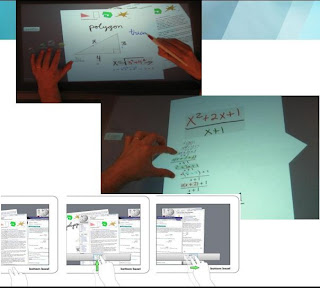So for the upcoming Milestone of the TUI project, we had to make a low-fidelity prototype of our proposed project. Consuelo, Heidi, Annie and I got together during the week and plowed through the assignment. During our craft-making process, we learned a lot about the limitations of our design, and adjusted it accordingly.
Since Heidi and Annie are super artistic, they took charge of drawing out the storyboard and writing up a feasible scenario for the Chameleon Suit.
 |
| Heidi and Annie working hard on the paper designs of the suit. |
Consuelo and I decided to tackle the actual construction of the suit.
We decided to use those rolls of multi-colored paper provided by Student Activities Office (since we didn't really go buy fabrics) along with some strings we found in the HCI lab. It turned out that the papers we used were super thin and easy to tear, which caused us SO MUCH trouble during the assembly of the suit. We based our suit on Consuelo's body size :) and I focused on making the top portion of the suit.
While measuring and cutting the paper, I realized just how difficult it was to actually make a piece of wearable clothing! There's so much details that need attention, such as shoulder width, arm length, how the shirt is going to fold/bend when the arm moves. So I told myself that before making a more expensive prototype, I'm going to research more into basic cloth designing concepts.
Soon after we started taping different papers together, Consuelo and I realized that because of the quality of the paper, it's almost impossible to fold/roll them up and expect the material to survive a second attempt. So instead of implementing the rolling/folding/bunching fabrics up technique we previously proposed, we adopted an alternative strategy (just for making this prototype) of making two different-sized sections of the limbs (arms and legs), and have the smaller section extend out of the larger section (kind of similar to how a biker would slide up their transparent visor, and the clear plastic would go over the actual helmet). This strategy ensure that the suit will still be wearable, and that it can actually survive our preliminary testing so we can showcase it in class the next day.
 |
The pant trouser here is divided up into two sections. The section on the lower leg will slide up into the bigger section.
|
We also decided to only implement the arm extension, leg extension, and skirt roll-up features of the suit (because we haven't really thought about how to implement the collar-changing aspect of the design). Eventually with much swearing, tearing (not the crying kind, but the paper ripping kind), and taping, we managed to get the suit on Consuelo.
Although the mechanisms on the suit are still very faulty, we thought this super-low fidelity prototype managed to deliver the basic idea of our project proposal.
Obviously we realized many shortcomings with the design of the suit (such as how to strategically place the extension mechanisms so they don't hinder/interfere with the wearer's movements, how to create a comfortable clothing template so the suit can actually be wore in real life without the wearer suffering from constant discomfort, and as well as the type of materials we will be using to make the suit, how sturdy they will have to be, etc).
Hopefully as we continue to modify our proposal, we will be able to come up with suitable solutions for these specific problems as well as think of other improvements we can apply to the suit.
 |
| Me having fun with the leftover googly eyes ^__^ (Okay, it's kind of creepy) |
 |
| Heidi and Annie's cute drawings! |






























